Low-Cost Pocket Fluorometer and Chemometric Tools for Green and Rapid Screening of Deoxynivalenol in Durum Wheat Bran
Abstract
1. Introduction
| Spectroscopic Platform | Sample | Detection | Sensitivity | Reference |
|---|---|---|---|---|
| Near-infrared | Wheat flour | Qualitative | Threshold: 450 μg/kg | [32] |
| Near-infrared | barley | Qualitative | Threshold: 1250 μg/kg | [33] |
| Near-infrared | Maize | Quantitative | Limit of detection: 200 μg/kg | [34] |
| Near-infrared | Whole wheat grain | Quantitative | Limit of detection: 230 μg/kg | [35] |
| Near-infrared | Wheat kernel | Quantitative | Limit of detection: 400 μg/kg | [37] |
| Near-infrared | Barley | Quantitative | Limit of detection: 300 μg/kg | [38] |
| Near-infrared | Ground durum wheat | Qualitative | Threshold: 1400 μg/kg | [45] |
| Near-infrared | Ground durum wheat | Qualitative | Threshold ≤ 1000 μg/kg 1000 μg/kg < Threshold ≤ 2500 μg/kg Threshold > 2500 μg/kg | [46] |
| Mid-infrared | Maize | Qualitative | Threshold: 1250 μg/kg | [39] |
| Mid-infrared | Maize | Qualitative | Threshold: 560 μg/kg | [48] |
| Infrared | Wheat flour | Quantitative | Limit of detection: 440 μg/kg | [41] |
| Infrared | Maize | Qualitative | Threshold: 1250 μg/kg | [49] |
| Near/mid infrared | Wheat bran | Qualitative | Threshold: 400 μg/kg | [47] |
| Visible/near infrared | Ground oats | Quantitative | Limit of detection: ~200 μg/kg | [44] |
| UV/visible/near infrared | Maize kernel | Quantitative | Limit of detection: 1500 μg/kg | [42] |
| UV/visible/near infrared | Ground wheat | Quantitative | Limit of detection: ~200 μg/kg | [43] |
| Fluorescence | Wheat flour | Quantitative | Limit of detection: ~2.4 mg/kg | [55] |
2. Results and Discussion
3. Materials and Methods
3.1. Reagents and Apparatus
3.2. Durum Wheat Bran Samples
3.3. Wheat Bran Sample Analysis by Reference Method
3.4. Fluorometer Assembly
3.5. Wheat Bran Sample Analysis by Fluorescence
3.6. Multivariate Statistical Analysis
- -
- sensitivity is defined as the fraction of samples belonging to Class A, correctly classified by the model and is a measure of the confidence level of the class space;
- -
- specificity is defined as the fraction of samples not belonging to Class A that are correctly rejected by the model;
- -
- accuracy is defined as the fraction of correctly classified samples with respect to the entire set.
4. Conclusions and Future Perspectives
Author Contributions
Funding
Institutional Review Board Statement
Informed Consent Statement
Data Availability Statement
Conflicts of Interest
References
- Garutti, M.; Nevola, G.; Mazzeo, R.; Cucciniello, L.; Totaro, F.; Bertuzzi, C.A.; Caccialanza, R.; Pedrazzoli, P.; Puglisi, F. The impact of cereal grain composition on the health and disease outcomes. Front. Nutr. 2022, 9, 888974. [Google Scholar] [CrossRef]
- Garg, M.; Sharma, A.; Vats, S.; Tiwari, V.; Kumari, A.; Mishra, V.; Krishania, M. Vitamins in Cereals: A critical review of content, health effects, processing losses, bioaccessibility, fortification, and biofortification strategies for their improvement. Front. Nutr. 2021, 8, 586815. [Google Scholar] [CrossRef] [PubMed]
- Polonskiy, V.; Loskutov, I.; Sumina, A. Biological role and health benefits of antioxidant compounds in cereals. Biol. Commun. 2020, 65, 53–67. [Google Scholar] [CrossRef]
- Borneo, R.; León, A.E. Whole grain cereals: Functional components and health benefits. Food Funct. 2012, 3, 110–119. [Google Scholar] [CrossRef]
- Williams, P.G. The benefits of breakfast cereal consumption: A systematic review of the evidence base. Adv. Nutr. 2014, 5, 636S–673S. [Google Scholar] [CrossRef] [PubMed]
- Tibola, C.S.; Fernandes, J.M.C.; Guarienti, E.M.; Nicolau, M. Distribution of Fusarium mycotoxins in wheat milling process. Food Control 2015, 53, 91–95. [Google Scholar] [CrossRef]
- Visconti, A.; Haidukowski, M.; Pascale, M. Reduction of deoxynivalenol during durum wheat processing and spaghetti cooking. Toxicol. Lett. 2004, 153, 181–189. [Google Scholar] [CrossRef]
- Kushiro, M. Effects of milling and cooking processes on the deoxynivalenol content in wheat. Int. J. Mol. Sci. 2008, 9, 2127–2145. [Google Scholar] [CrossRef]
- Sobrova, P.; Adam, V.; Vasatkova, A.; Beklova, M.; Zeman, L.; Kizek, R. Deoxynivalenol and its toxicity. Interdiscip. Toxicol. 2010, 3, 94–99. [Google Scholar] [CrossRef]
- Pestka, J.J. Deoxynivalenol: Mechanisms of action, human exposure, and toxicological relevance. Arch. Toxicol. 2010, 84, 663–679. [Google Scholar] [CrossRef]
- European Food Safety Authority. EFSA Panel on Contaminants in the Food Chain (CONTAM). EFSA J. 2017, 15, 4718. [Google Scholar]
- European Union. Commission Regulation (EC) No. 1126/2007 of 28 September 2007 (amending Regulation No. 1881/2006 of 19 December 2006) setting maximum levels for certain contaminants in foodstuffs as regards Fusarium toxins in maize and maize products. Off. J. Eur. Union 2007, L255, 14–17. [Google Scholar]
- Janik, E.; Niemcewicz, M.; Podogrocki, M.; Ceremuga, M.; Gorniak, L.; Stela, M.; Bijak, M. The existing methods and novel approaches in mycotoxins’ detection. Molecules 2021, 26, 3981. [Google Scholar] [CrossRef]
- Turner, N.W.; Subrahmanyam, S.; Piletsky, S.A. Analytical methods for determination of mycotoxins: A review. Anal. Chim. Acta 2009, 632, 168–180. [Google Scholar] [CrossRef] [PubMed]
- Pereira, V.L.; Fernandes, J.O.; Cunha, S.C. Mycotoxins in cereals and related foodstuffs: A review on occurrence and recent methods of analysis. Trends Food Sci. Technol. 2014, 36, 96–136. [Google Scholar] [CrossRef]
- Astoreca, A.; Ortega, L.; Fígoli, C.; Cardós, M.; Cavaglieri, L.; Bosch, A.; Alconada, T. Analytical techniques for deoxynivalenol detection and quantification in wheat destined for the manufacture of commercial products. World Mycotoxin J. 2016, 10, 111–120. [Google Scholar] [CrossRef]
- Zhou, S.; Xu, L.; Kuang, H.; Xiao, J.; Xu, C. Immunoassays for rapid mycotoxin detection: State of the art. Analyst 2020, 145, 7088–7102. [Google Scholar] [CrossRef]
- Lippolis, V.; Pascale, M.; Visconti, A. Optimization of a fluorescence polarization immunoassay for rapid quantification of deoxynivalenol in durum wheat-based products. J. Food Prot. 2006, 69, 2712–2719. [Google Scholar] [CrossRef]
- Valenzano, S.; Lippolis, V.; Pascale, M.; De Marco, A.; Maragos, C.M.; Suman, M.; Visconti, A. Determination of deoxynivalenol in wheat bran and whole-wheat flour by fluorescence polarization immunoassay. Food Anal. Methods 2014, 7, 806–813. [Google Scholar] [CrossRef]
- Agriopoulou, S.; Stamatelopoulou, E.; Varzakas, T. Advances in analysis and detection of major mycotoxins in foods. Foods 2020, 9, 518. [Google Scholar] [CrossRef]
- Bueno, D.; Istamboulie, G.; Muñoz, R.; Marty, J.L. Determination of mycotoxins in food: A review of bioanalytical to analytical methods. Appl. Spectrosc. Rev. 2015, 50, 728–774. [Google Scholar] [CrossRef]
- Cheli, F.; Ottoboni, M.; Fumagalli, F.; Mazzoleni, S.; Ferrari, L.; Pinotti, L. E-nose technology for mycotoxin detection in feed: Ready for a real context in field application or still an emerging technology? Toxins 2023, 15, 146. [Google Scholar] [CrossRef] [PubMed]
- Saccon, F.A.M.; Parcey, D.; Paliwal, J.; Sherif, S.S. Assessment of Fusarium and deoxynivalenol using optical methods. Food Bioprocess Technol. 2017, 10, 34–50. [Google Scholar] [CrossRef]
- Zareef, M.; Arslan, M.; Hassan, M.M.; Ahmad, W.; Ali, S.; Li, H.; Ouyang, Q.; Wu, X.; Hashim, M.M.; Chen, Q. Recent advances in assessing qualitative and quantitative aspects of cereals using nondestructive techniques. Trends Food Sci. Tech. 2021, 116, 815–828. [Google Scholar] [CrossRef]
- Lippolis, V.; Pascale, M.; Cervellieri, S.; Damascelli, A.; Visconti, A. Screening of deoxynivalenol contamination in durum wheat by MOS-based electronic nose and identification of the relevant pattern of volatile compounds. Food Control 2014, 37, 263–271. [Google Scholar] [CrossRef]
- Lippolis, V.; Cervellieri, S.; Damascelli, A.; Pascale, M.; Di Gioia, A.; Longobardi, F.; De Girolamo, A. Rapid prediction of deoxynivalenol contamination in wheat bran by MOS-based electronic nose and characterization of the relevant pattern of volatile compounds. J. Sci. Food Agric. 2018, 98, 4955–4962. [Google Scholar] [CrossRef]
- Camardo Leggieri, M.; Mazzoni, M.; Bertuzzi, T.; Moschini, M.; Prandini, A.; Battilani, P. Electronic nose for the rapid detection of deoxynivalenol in wheat using classification and regression trees. Toxins 2022, 14, 617. [Google Scholar] [CrossRef]
- Levasseur-Garcia, C. Updated overview of infrared spectroscopy methods for detecting mycotoxins on cereals (corn, wheat, and barley). Toxins 2018, 10, 38. [Google Scholar] [CrossRef]
- Freitag, S.; Sulyok, M.; Logan, N.; Elliott, C.T.; Krska, R. The potential and applicability of infrared spectroscopic methods for the rapid screening and routine analysis of mycotoxins in food crops. Compr. Rev. Food Sci. Food Saf. 2022, 6, 5199–5224. [Google Scholar] [CrossRef]
- Bilal, M.; Xiaobo, Z.; Arslan, M.; Tahir, H.E.; Li, Z.; Shi, J.; Usman, M. Nondestructive spectroscopic techniques for detection of fungal and mycotoxin infections in food products: A review. Spectroscopy 2020, 35, 28–36. [Google Scholar]
- Zhang, S.; Liu, S.; Shen, L.; Chen, S.; He, L.; Liu, A. Application of near-infrared spectroscopy for the nondestructive analysis of wheat fluor: A review. Curr. Res. Food Sci. 2022, 5, 1305–1312. [Google Scholar] [CrossRef]
- Tyska, D.; Mallmann, A.; Gressler, L.T.; Mallmann, C.A. Near-infrared spectroscopy as a tool for rapid screening of deoxynivalenol in wheat flour and its applicability in the industry. Food Addit. Contam. Part A 2021, 38, 1958–1968. [Google Scholar] [CrossRef] [PubMed]
- Dos Santos Caramês, E.T.; Peacetime, K.C.; Alves, L.T.; Lima-Pallone, J.A.; de Oliveira Rocha, L. NIR spectroscopy and chemometric tools to identify high content of deoxynivalenol in barley. Food Addit. Contam. Part A 2020, 37, 1542–1552. [Google Scholar] [CrossRef] [PubMed]
- Miedaner, T.; Han, S.; Kessel, B.; Ouzunova, M.; Schrag, T.; Urx, F.H.; Melchinger, A.E. Prediction of deoxynivalenol and zeralenone concentration in Fusarium graminearum inoculated backcross populations of maize by symptom rating and near-infrared spectroscopy. Plant Breed. 2015, 134, 529–534. [Google Scholar] [CrossRef]
- Dvořáček, V.; Prohasková, A.; Chrpová, J.; Štočková, L. Near infrared spectroscopy for deoxynivalenol content estimation in intact wheat grain. Plant Soil Environ. 2012, 58, 196–203. [Google Scholar] [CrossRef]
- Peiris, K.H.S.; Pumphrey, M.O.; Dowell, F.E. NIR absorbance characteristics of deodynivalenol and of sound and Fusarium-damaged wheat kernels. J. Near Infrared Spectrosc. 2009, 17, 213–221. [Google Scholar] [CrossRef]
- Pettersson, H.; Åberg, L. Near infrared spectroscopy for determination of mycotoxins in cereals. Food Control 2003, 14, 229–232. [Google Scholar] [CrossRef]
- Ruan, R.; Li, Y.; Lin, X.; Chen, P. Non-destructive determination of Deoxynivalenol levels in barley using near-infrared spectroscopy. Appl. Eng. Agric. 2002, 18, 549–553. [Google Scholar] [CrossRef]
- Sieger, M.; Kos, G.; Sulyok, M.; Godejohann, M.; Krska, M.; Mizaikoff, B. Portable infrared laser spectroscopy for on-site mycotoxin analysis. Sci. Rep. 2017, 7, 44028. [Google Scholar] [CrossRef]
- Hossain, M.Z.; Goto, T. Near- and mid-infrared spectroscopy as efficient tools for detection of fungal and mycotoxin contamination in agricultural commodities. World Mycotoxin J. 2014, 7, 507–515. [Google Scholar] [CrossRef]
- Li, F.L.; Xie, J.; Wang, S.; Wang, Y.; Xu, C.H. Direct qualitative and quantitative determination methodology for massive screening of DON in wheat flour based on multi-molecular infrared spectroscopy (MM-IR) with 2T-2DCOS. Talanta 2021, 234, 122653. [Google Scholar] [CrossRef]
- Smeesters, L.; Meulebroeck, W.; Raeymaekers, S.; Thienpont, H. Non-destructive detection of mycotoxins in maize kernels using diffuse reflectance spectroscopy. Food Control 2016, 70, 48–57. [Google Scholar] [CrossRef]
- Siuda, R.; Balcerowska, G.; Kupcewicz, B.; Lenc, L. A modified approach to evaluation of DON content in scab-damaged ground wheat by use of diffuse reflectance spectroscopy. Food Anal. Methods 2008, 1, 283–292. [Google Scholar] [CrossRef]
- Tekle, S.; Bjørnstad, Å.; Skinnes, H.; Dong, Y.; Segtnan, V.H. Estimating Deoxynivalenol content of ground oats using VIS-NIR spectroscopy. Cereal Chem. 2013, 90, 181–185. [Google Scholar] [CrossRef]
- De Girolamo, A.; Lippolis, V.; Nordkvist, E.; Visconti, A. Rapid and non-invasive analysis of deoxynivalenol in durum and common wheat by Fourier-Transform Near Infrared (FT-NIR) spectroscopy. Food Addit. Contam. Part A 2009, 26, 907–917. [Google Scholar] [CrossRef] [PubMed]
- De Girolamo, A.; Cervellieri, S.; Visconti, A.; Pascale, M. Rapid analysis of Deoxynivalenol in durum wheat by FT-NIR Spectroscopy. Toxins 2014, 6, 3129–3143. [Google Scholar] [PubMed]
- De Girolamo, A.; Cervellieri, S.; Cortese, M.; Porricelli, A.C.R.; Pascale, M.; Longobardi, F.; von Holst, C.; Ciaccheri, L.; Lippolis, V. Fourier transform near-infrared and mid-infrared spectroscopy as efficient tools for rapid screening of deoxynivalenol contamination in wheat bran. J. Sci. Food Agric. 2019, 99, 1946–1953. [Google Scholar] [CrossRef]
- Kos, G.; Lohninger, H.; Krska, R. Fourier transform mid-infrared spectroscopy with attenuated total replection (FT-IR/ATR) as a tool for the detection of Fusarium fungi on maize. Vib. Spectrosc. 2002, 29, 115–119. [Google Scholar] [CrossRef]
- Öner, T.; Thiam, P.; Kos, G.; Krska, R.; Schwenker, F.; Mizaikoff, B. Machine learning algorithms for the automated classification of contaminated maize at regulatory limits via infrared attenuated total reflection spectroscopy. World Mycotoxin J. 2019, 12, 113–122. [Google Scholar] [CrossRef]
- Horigome, J.; Kozuma, M.; Shirasaki, T. Fluorescence pattern analysis to assist food safety. Hitachi Rev. 2016, 7, 248–254. [Google Scholar]
- Sikorska, E.; Khmelinskii, I.; Sikorski, M. Fluorescence spectroscopy and imaging instruments for food quality evaluation, Chapter 19. In Evaluation Technologies for Food Quality; Zhong, J., Wang, X., Eds.; Woodhead Publishing-Elsevier: Amsterdam, The Netherlands, 2019; pp. 491–533. [Google Scholar]
- Fernandez-Romero, J.M.; Aguilar-Caballos, M.P. Fluorescence: Food Applications. In Encyclopedia of Analytical Science, 3rd ed.; Worsfold, P., Townshend, A., Poole, C., Eds.; Elsevier: Amsterdam, The Netherlands, 2018. [Google Scholar]
- Fujita, K.; Tsuta, M.; Kokawa, M.; Sugiyama, J. Detection of Deoxynivalenol using fluorescence excitation-emission matrix. Food Bioprocess Technol. 2010, 3, 922–927. [Google Scholar] [CrossRef]
- Fujita, K.; Tsuta, M.; Sugiyama, J.; Kushiro, M.; Shibata, M. Non-destructive measurement of Deoxynivalenol in wheat flour using fluorescence fingerprinting. Nippon. Shokuhin Kagaku Kogaku Kaishi 2011, 58, 375–381. [Google Scholar] [CrossRef][Green Version]
- Sugiyama, J.; Fujita, K.; Tsuta, M.; Kushiro, M. Detection of Deoxynivalenol in wheat flour using fluorescence fingerprint. Procedia Food Sci. 2011, 11, 1146–1151. [Google Scholar] [CrossRef]
- Armenta, S.; Esteve-Turrillas, F.A.; Garrigues, S.; de la Guardia, M. Green Approaches for Chemical Analysis; Chapter 1; Gionfriddo, E., Ed.; Elsevier Inc.: Amsterdam, The Netherlands, 2023; pp. 1–37. [Google Scholar]
- Pallone, J.A.L.; Caramês, E.T.D.S.; Alamar, P.D. Green analytical chemistry applied in food analysis: Alternative techniques. Curr. Opin. Food Sci. 2018, 22, 115–121. [Google Scholar] [CrossRef]
- Armenta, S.; Garrigues, S.; de la Guardia, M. Green Analytical Chemistry. TrAC Trends Anal. Chem. 2008, 27, 497–511. [Google Scholar] [CrossRef]
- Rasch, C.; Kumbe, M.; Löhmannsröben, H.G. Sensing of mycotoxin producing fungi in the processing of grains. Food Bioprocess Technol. 2010, 3, 908–916. [Google Scholar] [CrossRef]
- Bauriegel, E.; Herppich, W.B. Hyperspectral and chlorophyll fluorescence imaging for early detection of plant diseases, with special reference to fusarium spec. infections on wheat. Agriculture 2014, 4, 32–57. [Google Scholar] [CrossRef]
- Jackson, J.E. A User’s Guide to Principal Components; John Wiley & Sons Inc.: Hoboken, NJ, USA, 2003. [Google Scholar]
- Mafata, M.; Brand, J.; Kidd, M.; Medvedovici, A.; Buica, A. Exploration of data fusion strategies using component analysis and multiple factor analysis principal. Beverages 2022, 8, 66. [Google Scholar] [CrossRef]
- Liu, Z.; Forsyth, D.S.; Komorowski, J.P.; Hanasaki, K.; Kirubarajan, T. Survey: State of the Art in NDE data fusion techniques. IEEE Trans. Instrum. Meas. 2007, 56, 2435–2451. [Google Scholar] [CrossRef]
- Tharwat, A. Linear vs. quadratic discriminant analysis classifier: A tutorial. Int. J. Appl. Pattern Recognit. 2016, 3, 145–180. [Google Scholar] [CrossRef]
- Ballabio, D.; Todeschini, R. Multivariate Classification for Qualitative Analysis. In Infrared Spectroscopy for Food Quality Analysis and Control; Sun, D.W., Ed.; Elsevier Inc.: Amsterdam, The Netherlands, 2009; pp. 84–104. [Google Scholar]
- Olivieri, P.; Downey, G. Multivariate class modeling for the verification of food-authenticity claims. TrAC Trends Anal. Chem. 2012, 35, 74–86. [Google Scholar] [CrossRef]
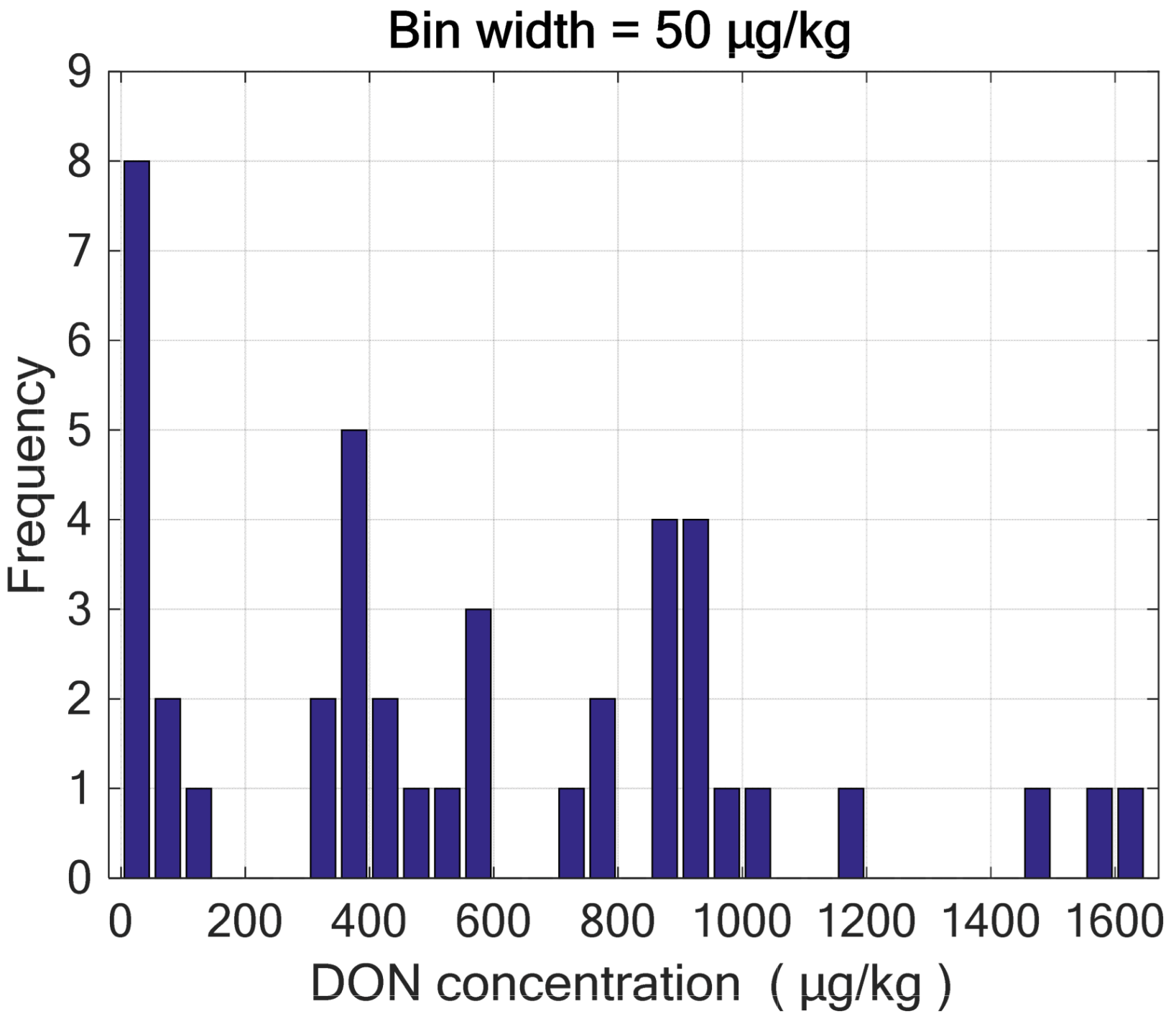

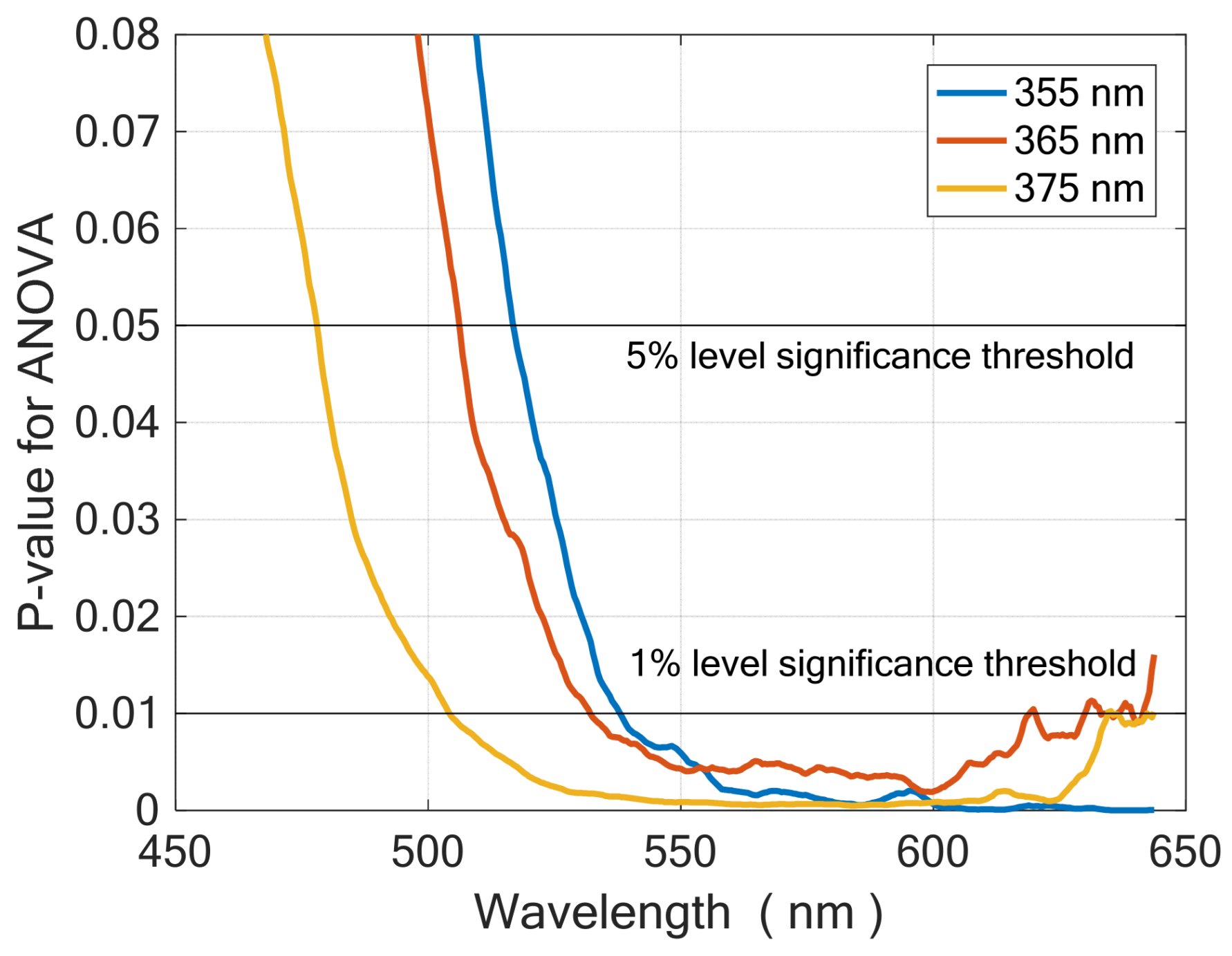

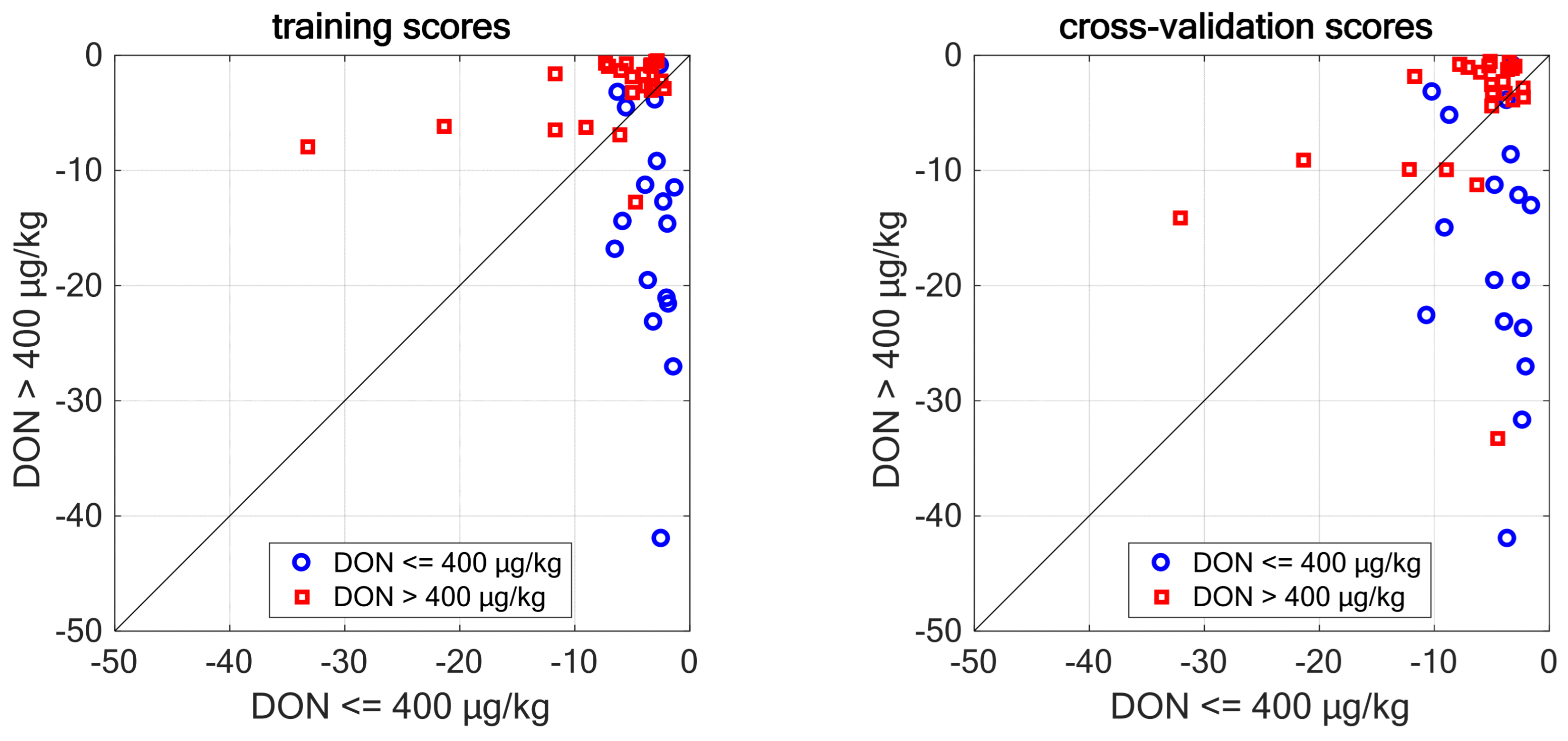
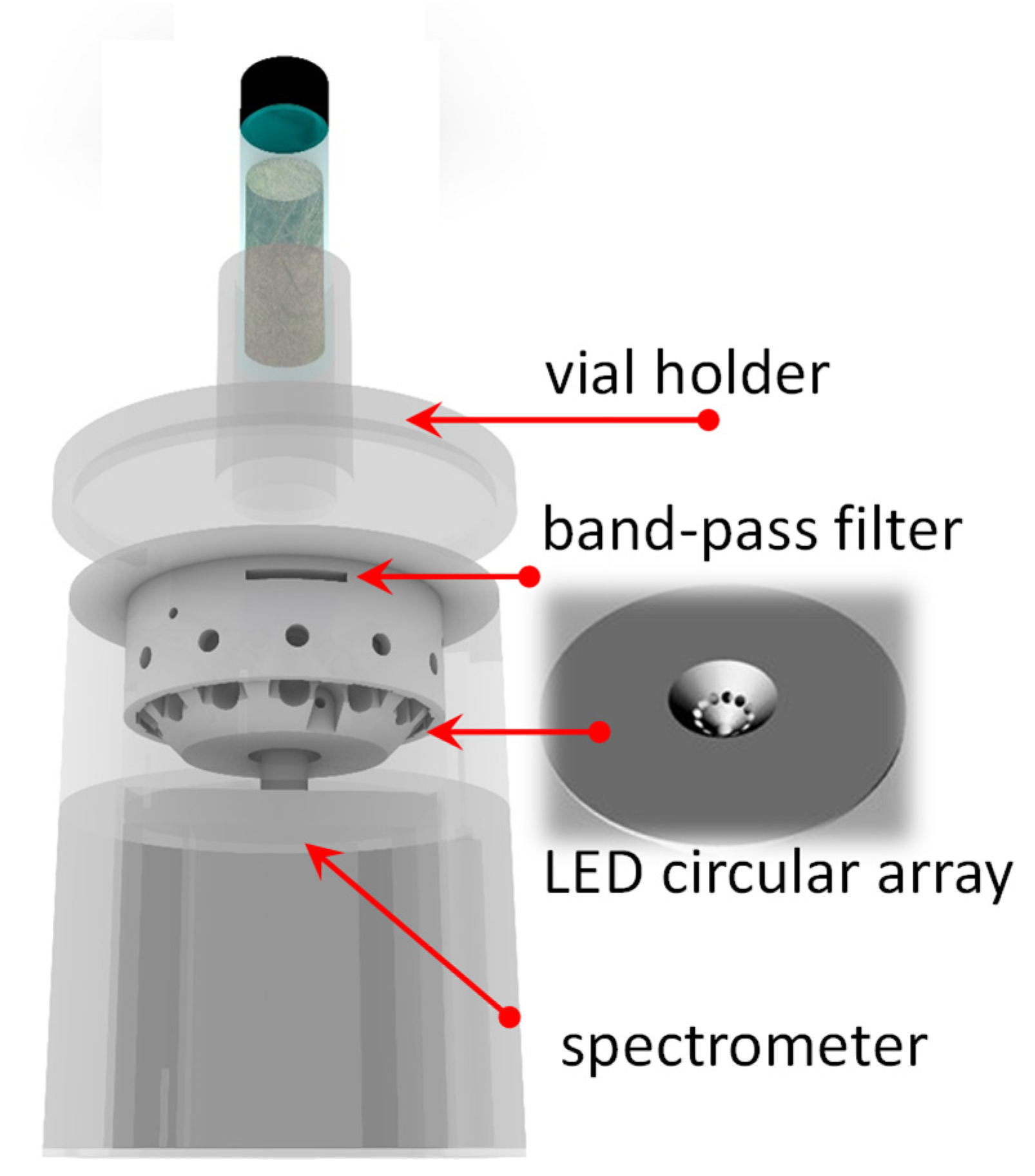
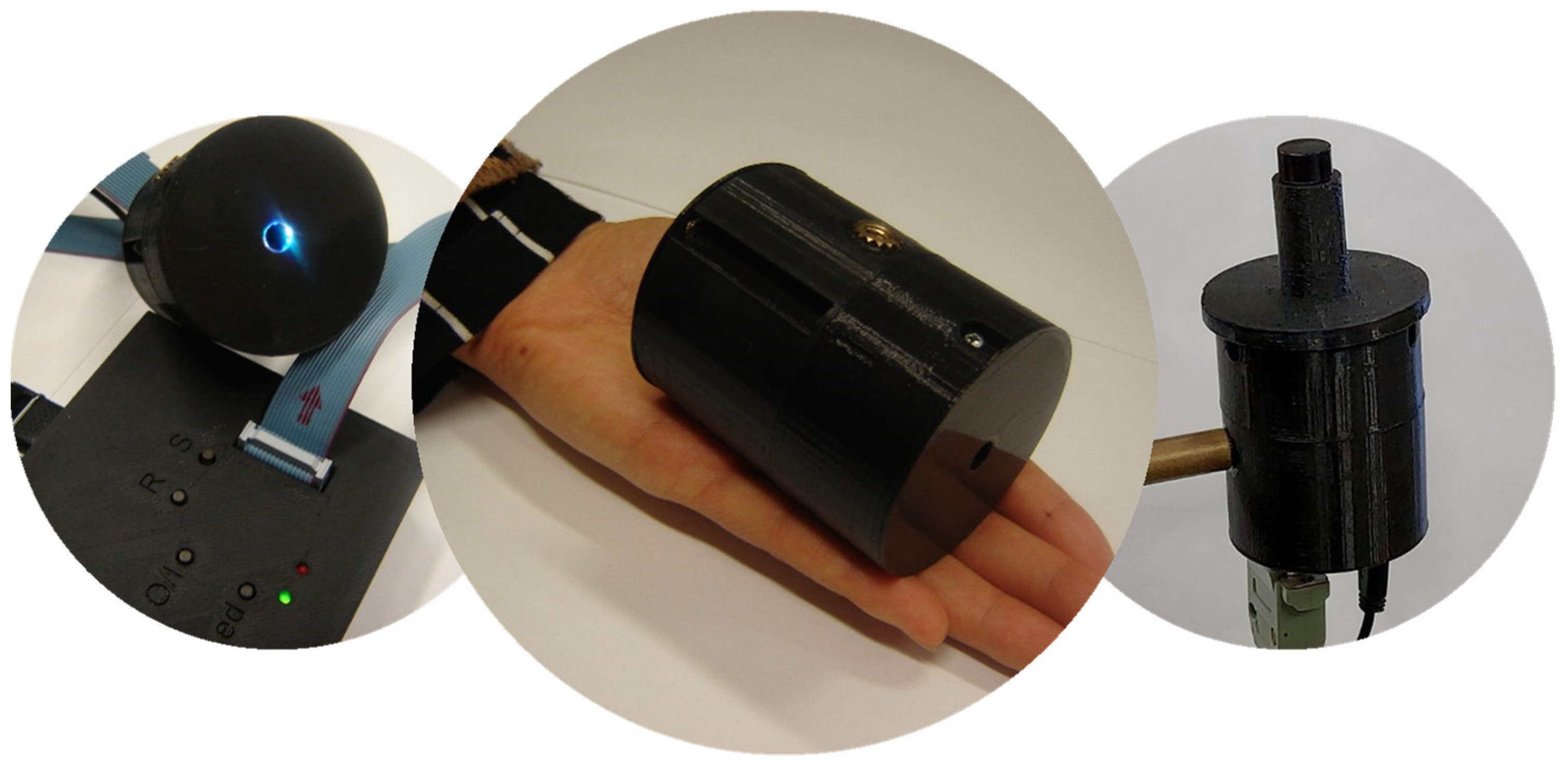
| Excitation Wavelength | Significance at 5% | Significance at 1% |
|---|---|---|
| 355 nm | above 517 nm | above 538 nm |
| 365 nm | above 506 nm | 532–619 nm |
| 375 nm | above 478 nm | 504–634 nm |
| Wavelength (nm) | Training | Cross-Validation | ||||
|---|---|---|---|---|---|---|
| Accuracy | Sensitivity | Specificity | Accuracy | Sensitivity | Specificity | |
| 355 | 81% | 83% | 78% | 74% | 75% | 72% |
| 365 | 71% | 71% | 72% | 69% | 67% | 72% |
| 375 | 74% | 75% | 72% | 74% | 75% | 72% |
| 355 + 365 | 83% | 83% | 83% | 76% | 75% | 78% |
| 365 + 375 | 86% | 88% | 83% | 79% | 83% | 72% |
| 355 + 375 | 86% | 88% | 83% | 79% | 75% | 83% |
| 355 + 365 + 375 | 88% | 88% | 89% | 74% | 71% | 78% |
Disclaimer/Publisher’s Note: The statements, opinions and data contained in all publications are solely those of the individual author(s) and contributor(s) and not of MDPI and/or the editor(s). MDPI and/or the editor(s) disclaim responsibility for any injury to people or property resulting from any ideas, methods, instructions or products referred to in the content. |
© 2023 by the authors. Licensee MDPI, Basel, Switzerland. This article is an open access article distributed under the terms and conditions of the Creative Commons Attribution (CC BY) license (https://creativecommons.org/licenses/by/4.0/).
Share and Cite
Ciaccheri, L.; De Girolamo, A.; Cervellieri, S.; Lippolis, V.; Mencaglia, A.A.; Pascale, M.; Mignani, A.G. Low-Cost Pocket Fluorometer and Chemometric Tools for Green and Rapid Screening of Deoxynivalenol in Durum Wheat Bran. Molecules 2023, 28, 7808. https://doi.org/10.3390/molecules28237808
Ciaccheri L, De Girolamo A, Cervellieri S, Lippolis V, Mencaglia AA, Pascale M, Mignani AG. Low-Cost Pocket Fluorometer and Chemometric Tools for Green and Rapid Screening of Deoxynivalenol in Durum Wheat Bran. Molecules. 2023; 28(23):7808. https://doi.org/10.3390/molecules28237808
Chicago/Turabian StyleCiaccheri, Leonardo, Annalisa De Girolamo, Salvatore Cervellieri, Vincenzo Lippolis, Andrea Azelio Mencaglia, Michelangelo Pascale, and Anna Grazia Mignani. 2023. "Low-Cost Pocket Fluorometer and Chemometric Tools for Green and Rapid Screening of Deoxynivalenol in Durum Wheat Bran" Molecules 28, no. 23: 7808. https://doi.org/10.3390/molecules28237808
APA StyleCiaccheri, L., De Girolamo, A., Cervellieri, S., Lippolis, V., Mencaglia, A. A., Pascale, M., & Mignani, A. G. (2023). Low-Cost Pocket Fluorometer and Chemometric Tools for Green and Rapid Screening of Deoxynivalenol in Durum Wheat Bran. Molecules, 28(23), 7808. https://doi.org/10.3390/molecules28237808










